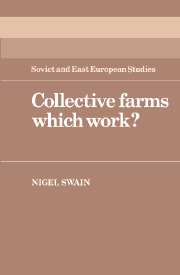Book contents
- Frontmatter
- Contents
- Preface
- Introduction
- PART I ‘FAMILY LABOUR’ AND ‘SOCIALIST WAGE LABOUR’ IN HUNGARY'S CO-OPERATIVE AGRICULTURE: THE INCORPORATION OF PETTY COMMODITY PRODUCTION
- 1 ‘Family labour’ in the achievement and consolidation of collectivised agriculture, 1946–68
- 2 ‘Family labour’ and ‘socialist wage labour’: from integration to symbiosis, 1968–77
- PART II MEMBERS AND MANAGERS
- PART III MANAGERIAL CONTROL IN AGRICULTURE
- Conclusion
- Appendix I The transformation of Hungarian agriculture
- Appendix II Ancillary enterprises within agricultural co-operatives: number of units engaged in non-agricultural activity
- Notes
- References and bibliography
- Index
1 - ‘Family labour’ in the achievement and consolidation of collectivised agriculture, 1946–68
Published online by Cambridge University Press: 10 December 2009
- Frontmatter
- Contents
- Preface
- Introduction
- PART I ‘FAMILY LABOUR’ AND ‘SOCIALIST WAGE LABOUR’ IN HUNGARY'S CO-OPERATIVE AGRICULTURE: THE INCORPORATION OF PETTY COMMODITY PRODUCTION
- 1 ‘Family labour’ in the achievement and consolidation of collectivised agriculture, 1946–68
- 2 ‘Family labour’ and ‘socialist wage labour’: from integration to symbiosis, 1968–77
- PART II MEMBERS AND MANAGERS
- PART III MANAGERIAL CONTROL IN AGRICULTURE
- Conclusion
- Appendix I The transformation of Hungarian agriculture
- Appendix II Ancillary enterprises within agricultural co-operatives: number of units engaged in non-agricultural activity
- Notes
- References and bibliography
- Index
Summary
In the years between 1946 and 1968 Hungary not only established collectivised agriculture throughout the country, it also provided it with a sound financial basis on which to build successfully in the 1970s. These two processes – establishment and consolidation – were not straightforward, nor were they unidirectional, and the approach adopted towards labour, and primarily ‘family labour’, was central to the final realisation of both. Concessions in favour of private peasant production played a central role in Hungary's successful third collectivisation in 1959–61; whilst a crucial factor in the consolidation process from the early 1960s to 1968 was the recognition that, for collective agriculture to be successful, it could not be based on farm-wide, communal ‘family labour’ alone. That is, Hungarian agricultural co-operatives very soon realised that the logic of the ‘family economy’ in relation to individuals' income and wage-costs could not be extended from the family farm to a large, complex organisation. Thus, while incorporating and indirectly relying on private sector ‘family labour'on members' household plots, the communal sector of the farm replaced ‘family labour’ writ large with a form of wage labour. These two concerns – the need for concessions to private ‘family labour’ in the achievement of collectivised agriculture and the retreat from communal ‘family labour’ in its consolidation – constitute the primary focus of this chapter. A subsidiary interest is collectivised agriculture's readiness to incorporate certain forms of individual ‘family labour’ into the communal sector as well. Although it is not argued that the approach adopted towards labour was the single most important determinant of successful collectivisation – the government's readiness to provide sufficient funds to cover the costs of collectivisation being equally significant – its centrality to the process will be clear.
- Type
- Chapter
- Information
- Collective Farms which Work? , pp. 25 - 50Publisher: Cambridge University PressPrint publication year: 1985



